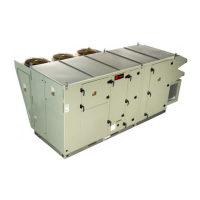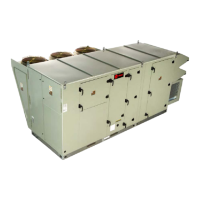OAU-SVX007A-EN 99
Alarms and Troubleshooting
Microprocessor Control
The Main Unit Display and RTRM have the ability to provide
the service personnel with some unit diagnostics and system
status information.
1. Verify that the Liteport LED on the RTRM is burning
continuously. If the LED is lit, go to Step 3.
2. If the LED is not lit, verify that 24 Vac is presence between
J1-1 and J1-2. If 24 Vac is present, proceed to Step 3. If
24 Vac is not present, check the unit main power supply,
check transformer (TNS1). Proceed to Step 3 if necessary.
3. Utilizing “Method 1” in the RTRM “System Status Checkout
Procedure”, check the following:
• System status
• Cooling status
If a System failure is indicated, proceed to Step 4. If no
failures are indicated, proceed to Step 5.
4. If a System failure is indicated, recheck Step 1 and Step 2.
If the LED is not lit in Step 1, and 24 Vac is present in Step
2, the RTRM has failed. Replace the RTRM.
5. If no failures are indicated, use one of the override options
to start the unit. Following the override procedure will allow
you to check all of the operating modes, and all of the
external controls (relays, contactors, etc.) for each
respective mode.
6. Refer to the sequence of operations for each mode, to
assist in verifying proper operation. Make the necessary
repairs and proceed to Step 7.
7. If no abnormal operating conditions appear in the Override
mode, release the override and turn the power “Off” at the
main power disconnect switch.
System Alarms
The main unit display has built in alarms to help the operator
troubleshoot system failures. This section will describe these
alarms and provide a guide to troubleshooting the all unit
operating modes.
Comprehensive system alarms and diagnostics are accessed
through the alarms icon at the unit display discussed later in
the section, or through Tracer TU programming on connected
computer. Sensor failures may be viewed through the alarms
icon.
If an alarm is present, the main indicator light on the UC600 will
blink red. If the optional unit display is installed, the alarm icon
on the display will register ALARM, illuminate red and flash.
Important: The space temperature sensor (SPTC) and
space relative humidity sensor (SPHC) will
read failed if they are not connected; they will
Alarm as “In Fault.”
Sensor Failure Alarm Display
Press the alarm button on the home display of the unit display
to display system sensor status.
WARNING
Hazardous Service Procedures!
Failure to follow all precautions in this manual and on
the tags, stickers, and labels could result in death or
serious injury.
Technicians, in order to protect themselves from
potential electrical, mechanical, and chemical hazards,
MUST follow precautions in this manual and on the
tags, stickers, and labels, as well as the following
instructions: Unless specified otherwise, disconnect all
electrical power including remote disconnect and
discharge all energy storing devices such as capacitors
before servicing. Follow proper lockout/tagout
procedures to ensure the power can not be
inadvertently energized. When necessary to work with
live electrical components, have a qualified licensed
electrician or other individual who has been trained in
handling live electrical components perform these
tasks.
AVERTISSEMENT
Procédures d’entretien dangereuses!
Le non-respect de toutes les précautions contenues
dans ce manuel ainsi que sur les étiquettes et les
autocollants peut entraîner des blessures graves voire
mortelles.
Les techniciens, afin d’être protégés des éventuels
risques électriques, mécaniques et chimiques,
DOIVENT suivre les précautions contenues dans ce
manuel, sur les étiquettes et les autocollants, ainsi que
les instructions suivantes : Sauf indication contraire,
coupez toute l’alimentation électrique y compris les
disjoncteurs à distance et déchargez tous les
dispositifs de stockage d’énergie comme les
condensateurs avant l’entretien. Respectez les
procédures de verrouillage et d’étiquetage appropriées
pour éviter tout risque de remise sous tension
accidentelle. S’il est nécessaire de travailler avec des
composants électriques sous tension, demandez à un
électricien qualifié et agréé ou à une autre personne
ayant la formation nécessaire pour manipuler des
composants électriques sous tension d’exécuter ces
tâches.

